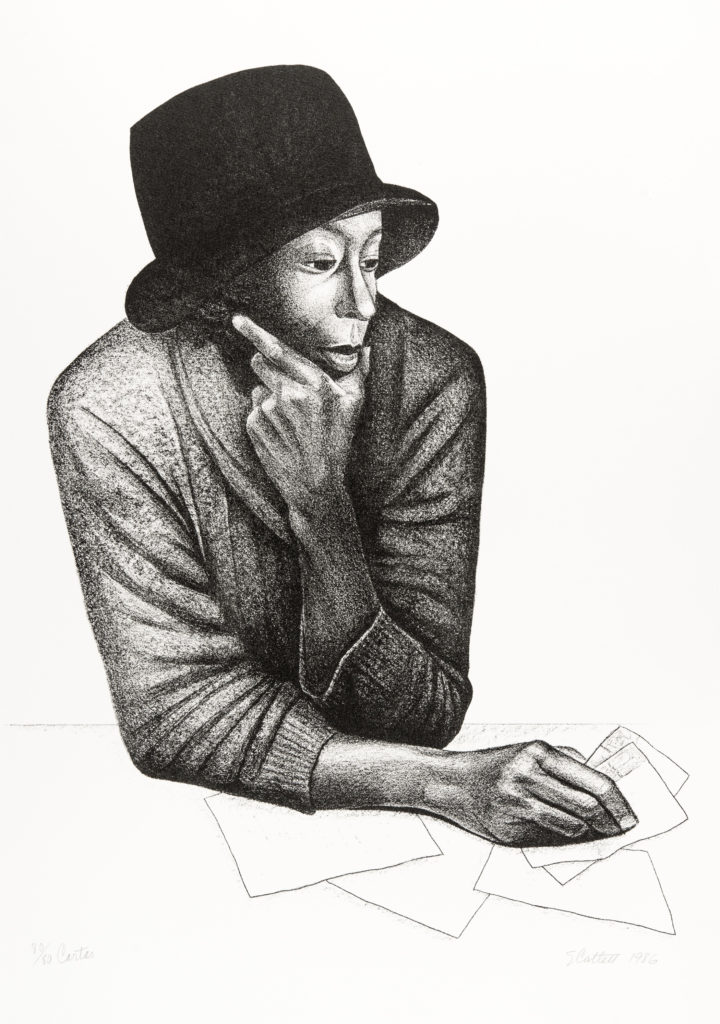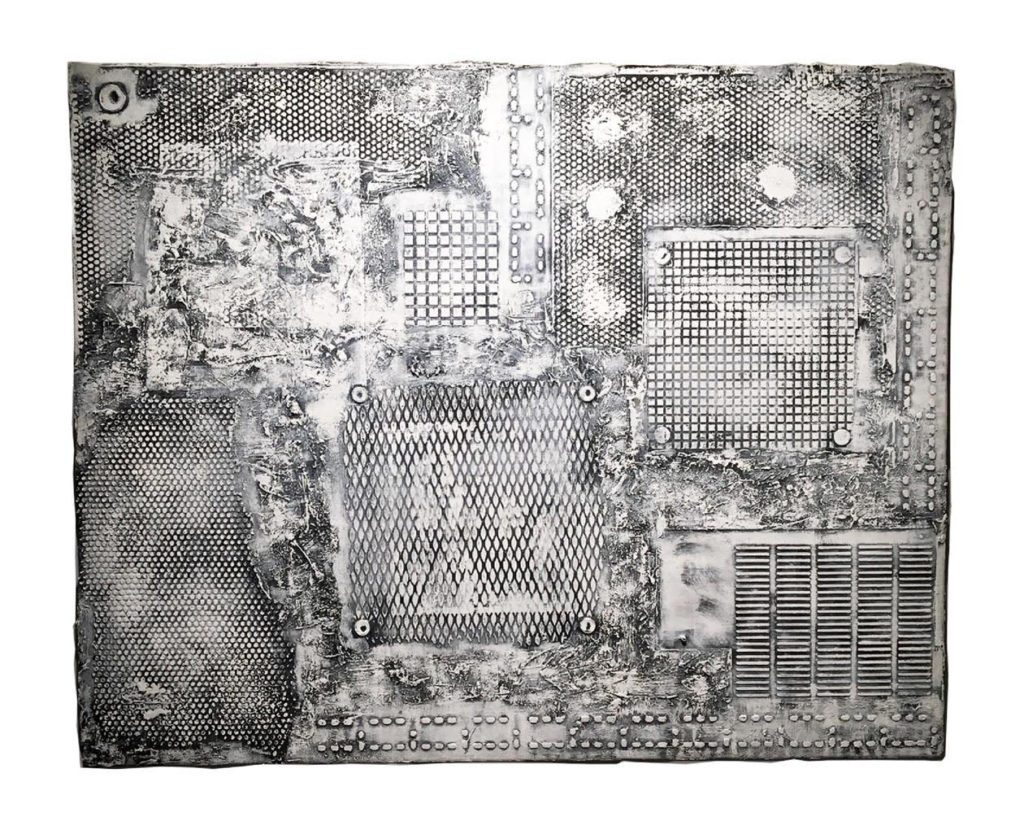By Patsy Isenberg
Someone was heard saying that the Flint Farmer’s Market is the jewel of Flint. Well, there actually are several jewels here, and one of the brightest is the MW Gallery downtown. Illustrating the point is the MW’s new exhibit, “20/20 Influential Artists of the 20th Century,” comprised of work by more than 20 notable “artists of the African diaspora and those who reflect on it.”
The rotating exhibits at MW are from the 600-piece collection of Maryanne Mott, daughter of C.S. and Ruth Mott. She started procuring the pieces with her late husband Herman Warsh 17 years ago, according to Stephanie James, Mott-Warsh curator and collection educator. Maryanne Mott grew up at the Mott family estate, Applewood, and now lives in California. As East Village Magazine detailed when the gallery opened in June, 2016, she and her husband maintained close connections with Flint, both through their participation in the Mott Foundation and in their devotion to sharing art with the Flint community.
The “20/20” exhibit, all from the Mott-Warsh collection, features pieces by distinguished black artists such as Jacob Lawrence, Elizabeth Catlett, Charles White, Jack Whitten, Betye Saar and Hale Woodruff. Some are African American while others are of the African diaspora group which simply means that the artist is black but settled in a place outside his or her ancestral homeland.
Within some of the works there is a quickly-perceived narrative from the artist’s black experience which tends also to make a statement. Other works are abstract or possess themes or techniques that reflect their elevated skill at painting, drawing, photography or sculpture derived from their unique experiences. Genre-wise, it’s a very diverse collection and also is derived from many different 20th century art movements. Some of the artists are still at work while others have died.
Three Pieces From the “20/20” Exhibit

Elizabeth Catlett, Cartas, 1986. Lithograph, 30″ x 22″ Copyright Catlett Mora Family Trust/Licensed by VAGA New York, NY. http;//vagarights.com/ Digital image courtesy MW Gallery.
It’s difficult to pick just a few works from the exhibit to describe, but one piece that jumps out is Cartas (letters), an Elizabeth Catlett black and white lithograph that shows a woman with a dreamy expression at a table or desk with letters. Catlett was born in Washington D.C. in 1915, and attended Howard University and the University of Iowa where she studied with the well-known painter Grant Wood, painter of American Gothic. She often worked in sculpture as well and studied ceramics at the Art Institute of Chicago and lithography at South Side Community Arts Center, also in Chicago. Catlett was a lifelong activist, rubbing elbows with many other artists involved in social change. She spent a lot of time in Mexico, eventually becoming a Mexican citizen.
This print captures the subject exquisitely. As is evident in this example, she focussed on the human figure throughout her career, as opposed to abstracts, paying special attention to women from the the African American and Mexican working classes.
Highlighting the diversity of the exhibit, Jack Whitten’s Southern Exposure is a 40” x 50” abstract painting (also 1986) that has all the qualities of abstract expressionism. This genre of painting explores almost purely the visual reaction to a work of art without narrative. Whitten used a very heavy impasto to deliver a high textural look low in color.

Jack Whitten, Southern Exposure, 1986. Acrylic on Canvas. Courtesy Alexander Gray Associates, New York
He was born in Bessemer, Alabama in 1939 and took a bus to New York City in 1960 where he was introduced to the abstract painters from that era. He was the only black student in his class at Cooper Union but also became acquainted with other up-and-coming black artists (some also included in the 20/20 exhibit) who were creating more representational works. While he absorbed influences from both sides, Whitten remained an abstract painter.
In Betye Saar’s mixed media assemblages Dark and Sandy, from 2002, the artist arranged carefully-selected found objects into shadow box frames, each with a photograph of an African American man from the past. The items within tell stories of how racial stereotypes are sometimes the result of, or promoted by, consumer products found in our lives. In Sandy, Stephanie James explains, “The inclusion of the dice, playing cards, pocketknife, and the face of a watch suggests that he may have acquired them through gambling—a man of the streets who is popular, but who can also be dangerous. Again, they are items Saar selected to convey a certain stereotype applied to blacks during an earlier era.”

Betye Saar, Sandy, 2002. Mixed media on paper. Copyright Estate of Betye Saar, Courtesy of Michael Rosenfeld Gallery, LLC, New York, NY.
The two pieces are also named for the tendency to get specific when describing an African American’s skin color. James comments about the name, Sandy, that Saar, “is examining the practice of assigning names to African Americans based on their skin color, so ‘sandy’ would be a name applied to a person of a lighter hue in the spectrum of skin color that African Americans have—which itself is an outcome of slavery and the rape of African women by the white men who enslaved them.” Saar, born in 1926 in Los Angeles, studied art in numerous institutions in California in her early years and came into contact with many other influential artists of her day, and other activists. According to Wikipedia, “her work is considered highly political, as she challenged negative ideas about African-Americans throughout her career.”
Also on Exhibit at MW
In a smaller room and hallway at the gallery a secondary exhibit is being presented in conjunction with “20/20.” It’s “Women’s Voices,” an exhibit of work by black “women who spoke their truth before it was acceptable,” James said. Most of the works are by slightly lesser-known, younger artists. Some of their work is a little edgy and somewhat controversial; all are very beautiful and thought-provoking.
A film also is currently being screened in MW’s Black Box Video Gallery. “Free, White and 21” by Howardena Pindell is a short, must-see “historic and pivotal film” created in 1980, before the digital age.
More About the Gallery
James is extremely knowledgeable about the M-W collection and the “20/20” exhibit. Formerly of the Detroit Institute of Arts, James assembled the pieces for the “20/20” exhibit herself.
She pointed out that the establishment of the gallery has allowed large portions of the Mott-Warsh collection to have a permanent home, with the option of changing exhibits as desired and without keeping much of it in storage. But Maryanne Mott’s main goal with the collection, James said, is to loan smaller portions of the collection through placement in institutions in Flint and other parts of the country; she said Mott wants the art to educate, to be shared with others, and to be enjoyed. Selections from the collection also are on loan to The Flint Institute of Music, The Flint Public Library, Mott Community College, The Ruth Mott Foundation, the Genesee County Health Department, the Genesys Downtown Flint Health Center, Mt. Olive Missionary Baptist Church, Ebenezer Ministries, and Applewood Estate.
MW Gallery is located at 815 S. Saginaw St., downtown Flint (on the corner of Saginaw and Court streets), 810-835-4900. Gallery entrance is on E. Court Street. The gallery is open 11 a.m.-6 p.m. Thursday and Friday and 11 a.m. to 5 p.m. Saturday. The “20/20” and “Women’s Voices” exhibits can be seen at MW Gallery until July 27.
EVM staff writer Patsy Isenberg can be reached at pisenber@gmail.com.


You must be logged in to post a comment.